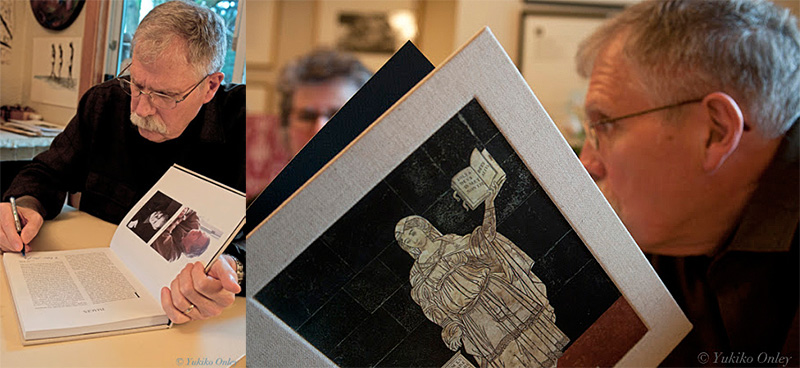E.D. Blodgett signing the book, March 2013
| |
|
E.D. BLODGETT It would be difficult to imagine a poem without an image. It is the skeleton on which the poem acquires its shape, and more than once one wonders where an extraordinary image might have come from. Was it glimpsed in a dream, a walk by a river, a brief recollection? Through the image the poem takes shape in the mind. It may appear quite simple, such as a moon rising over a lake, or more complex–a moon seen through winter trees. Yet both moons are in their way complex, inasmuch as both are subject to motion (rising) or fragmentation (broken by branches). This is because images ‘acquire’ their shapes. It is something we like to think that they put on or ‘take.’ They unfold or, to put it another way, they have to wait for each word that, as they move through the poem, continually modify our perception of the image. We speak a poem, yet it takes time to speak all of it, to allow it to display all of its possibilities. At a certain point in our reading, however, we cannot help but notice that a word or words break away from what seems to be merely an unfolding image. We are then reminded that the image is ‘merely’ composed of words. We remember that no image is ‘merely’ an image, free of us and our associations. We cannot help believing in the fact that images are primarily visual, as if they were visible just by looking. The visual arts draw us naturally to such a belief. Simply by looking we see a horse on a horizon, a ship at sea, a goddess doing what goddesses do. We forget immediately that these are images that only patterns of line and colour can set before us to see, until a line or colour seems to disturb the pattern. When it is perfectly clear, however, that all imagery is never something that leaps before us shouting ‘Ecce!,’ we begin to understand how much an image is a sequence of words as much as an interplay of line and colour. In poetry, for example, such sequences easily produce symbols that make clear the extent to which images are thought: they spring from the spirit, rather than lie before the eye. When I was approached to write a series of prose poems in which a series of visual images would be the point of departure, rather than something that simply occurred to me at random, I was initially unsure of how I would proceed. Some things were, however, simplified. The works of art were arranged so as to cluster similar figures (e.g., Sibyls) or themes. Nevertheless, the key question was how to respond. Given the brevity of space at my disposal, I abandoned very quickly any mimetic attempts, and it occurred to me that brevity was the key. But brevity could only be achieved by patiently allowing what I saw to enter my mind’s eye on its way to the spirit, that strange chamber where words seem to ask to be spoken, as if they are a kind of answer. I found myself always looking in two places more or less at once: at the given image and then into the chamber of the spirit. But this is slightly imprecise because while I was looking in the first place, I was listening in the second. That interplay of the senses between them seemed to give off a kind of light that allowed for a new way of seeing/hearing that was for me a kind of illumination that filled me with a kind of wonder that led me to begin to speak to what I saw, rather than of what I saw, as if the works of art I was gazing at were asking to be addressed in such a way that they could be heard. What I wanted was to allow them to speak through me. Like all images they remain filtered, but in such a way that the process of filtering is not obscured, almost as if to say that all imagery resides in its filter, or is filter. |
| |
